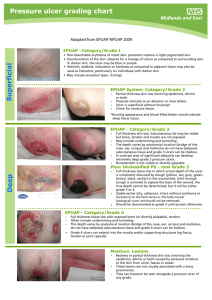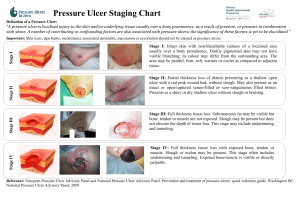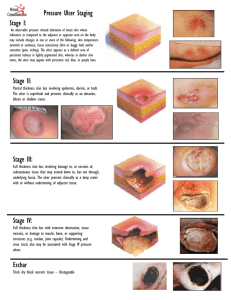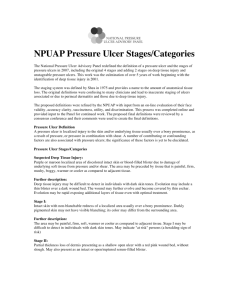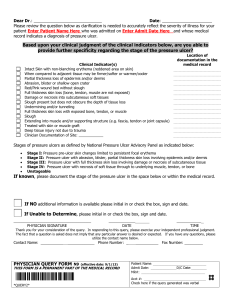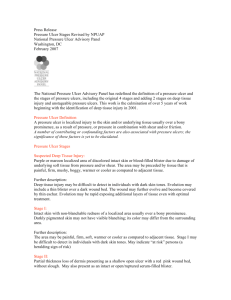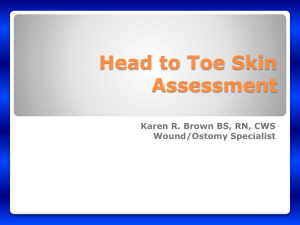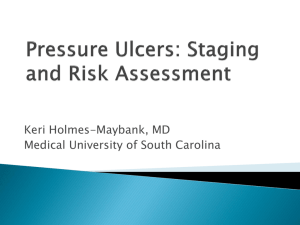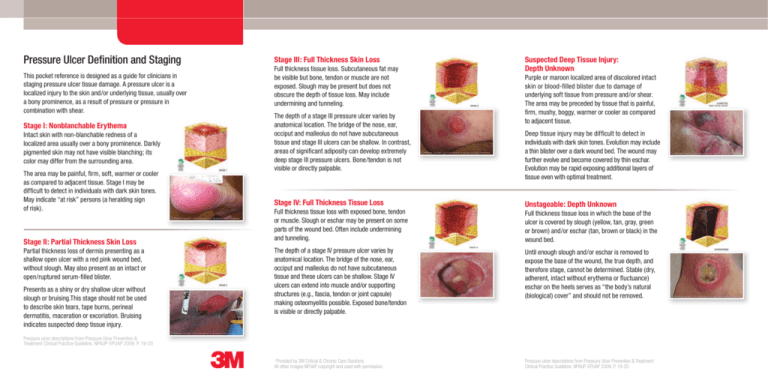
Pressure Ulcer Definition and Staging
This pocket reference is designed as a guide for clinicians in
staging pressure ulcer tissue damage. A pressure ulcer is a
localized injury to the skin and/or underlying tissue, usually over
a bony prominence, as a result of pressure or pressure in
combination with shear.
Stage I: Nonblanchable Erythema
Intact skin with non-blanchable redness of a
localized area usually over a bony prominence. Darkly
pigmented skin may not have visible blanching; its
color may differ from the surrounding area.
The area may be painful, firm, soft, warmer or cooler
as compared to adjacent tissue. Stage I may be
difficult to detect in individuals with dark skin tones.
May indicate “at risk” persons (a heralding sign
of risk).
Stage II: Partial Thickness Skin Loss
Partial thickness loss of dermis presenting as a
shallow open ulcer with a red pink wound bed,
without slough. May also present as an intact or
open/ruptured serum-filled blister.
Presents as a shiny or dry shallow ulcer without
slough or bruising.This stage should not be used
to describe skin tears, tape burns, perineal
dermatitis, maceration or excoriation. Bruising
indicates suspected deep tissue injury.
Stage III: Full Thickness Skin Loss
Suspected Deep Tissue Injury:
Depth Unknown
Full thickness tissue loss. Subcutaneous fat may
be visible but bone, tendon or muscle are not
exposed. Slough may be present but does not
obscure the depth of tissue loss. May include
undermining and tunneling.
Purple or maroon localized area of discolored intact
skin or blood-filled blister due to damage of
underlying soft tissue from pressure and/or shear.
The area may be preceded by tissue that is painful,
firm, mushy, boggy, warmer or cooler as compared
to adjacent tissue.
The depth of a stage III pressure ulcer varies by
anatomical location. The bridge of the nose, ear,
occiput and malleolus do not have subcutaneous
tissue and stage III ulcers can be shallow. In contrast,
areas of significant adiposity can develop extremely
deep stage III pressure ulcers. Bone/tendon is not
visible or directly palpable.
Deep tissue injury may be difficult to detect in
individuals with dark skin tones. Evolution may include
a thin blister over a dark wound bed. The wound may
further evolve and become covered by thin eschar.
Evolution may be rapid exposing additional layers of
tissue even with optimal treatment.
Stage IV: Full Thickness Tissue Loss
Unstageable: Depth Unknown
Full thickness tissue loss with exposed bone, tendon
or muscle. Slough or eschar may be present on some
parts of the wound bed. Often include undermining
and tunneling.
The depth of a stage IV pressure ulcer varies by
anatomical location. The bridge of the nose, ear,
occiput and malleolus do not have subcutaneous
tissue and these ulcers can be shallow. Stage IV
ulcers can extend into muscle and/or supporting
structures (e.g., fascia, tendon or joint capsule)
making osteomyelitis possible. Exposed bone/tendon
is visible or directly palpable.
Full thickness tissue loss in which the base of the
ulcer is covered by slough (yellow, tan, gray, green
or brown) and/or eschar (tan, brown or black) in the
wound bed.
Until enough slough and/or eschar is removed to
expose the base of the wound, the true depth, and
therefore stage, cannot be determined. Stable (dry,
adherent, intact without erythema or fluctuance)
eschar on the heels serves as “the body’s natural
(biological) cover” and should not be removed.
1
Pressure ulcer descriptions from Pressure Ulcer Prevention &
Treatment Clinical Practice Guideline. NPAUP-EPUAP 2009. P. 19-20
Provided by 3M Critical & Chronic Care Solutions
All other images NPUAP copyright and used with permission.
1
Pressure ulcer descriptions from Pressure Ulcer Prevention & Treatment
Clinical Practice Guideline. NPAUP-EPUAP 2009. P. 19-20
Frequent Anatomical Sites
of Pressure Ulcers
Occiput
Ear
Acromion process
Scapula
Thoracic vertebrae
Olecranon (elbow)
Lumbar vertebrae
Sacrum
Coccyx
For more information, visit www.3m.com/WoundConditions,
Ischial tuberosity
Trochanter
contact your 3M Critical & Chronic Care Representative or
call the 3M Helpline at 1-800-228-3957.
Lateral/medial epicondyle
(knee)
Pre-tibial crest (shin)
Medial malleolus
(inner ankle)
Lateral malleolus
(outer ankle)
Calcaneous (heel)
Pressure Ulcer Assessment Parameters
Perform head to toe assessment upon admission and intervals consistent with patient
condition and facility policy and procedures.
tLocation/
Distribution
tDimensions
– length
– width
– depth
Critical & Chronic Care Solutions Division
3M Health Care
2510 Conway Avenue
St. Paul, MN 55144
USA
1-800-228-3957
www.3M.com/C3SD
3M is a trademark of 3M Company.
Please recycle. Printed in U.S.A.
© 1987, 2013. All rights reserved.
70-2008-3143-9
tExudate
– color
– consistency
– odor
– amount
tCondition
– base
– surrounding
– skin
– sinus tracts/
undermining
tInfection signs
or symptoms
– local vs.
systemic
tPain
tPresence
of medical
device(s)
Other Types of Skin Damage Commonly Confused
with Pressure Ulcers
Incontinence-Associated Dermatitis –
inflammatory damage of the skin due to
exposure to urine and/or stool. Skin is
erythemic and skin loss may or may not
be present. In addition to the perineum,
areas of involvement may include: lower
abdomen, anterior and medial thighs and
groin folds; sacrococcygeal area, buttocks,
and posterior thighs. Damage is not localized
to a bony prominence and tends to be diffuse
conforming to area of exposure to urine
or stool.
Moisture lesions – superficial, clean
lesions resulting from exposure to moisture,
or the interaction of friction and moisture.
Lesions are clean, without necrotic tissue.
Lesions are often irregularly shaped and
edges are not well defined. Localization
over a bony prominence is not typical.
Common locations include the gluteal fold,
the sacrococcygeal area and opposing
surfaces of the buttocks. Maceration of
the surrounding skin is common.

